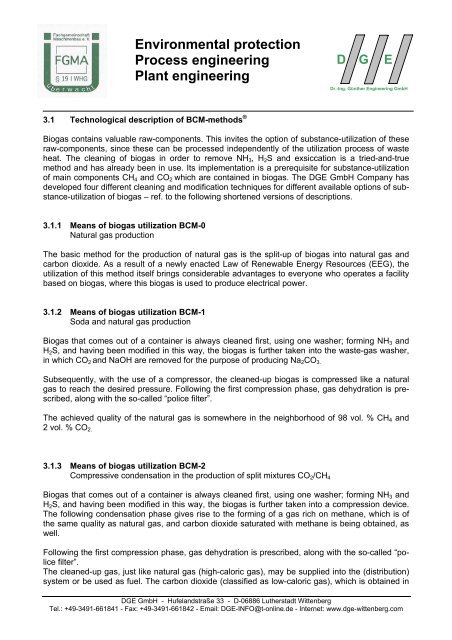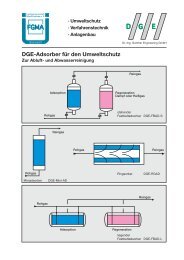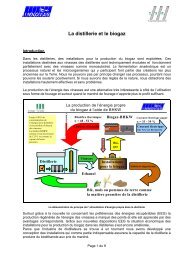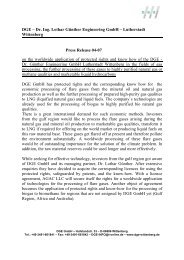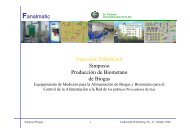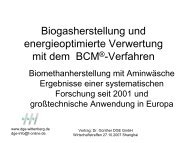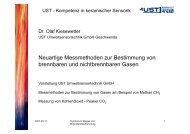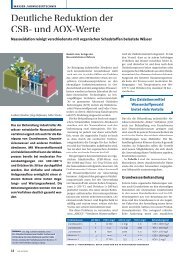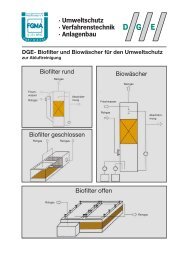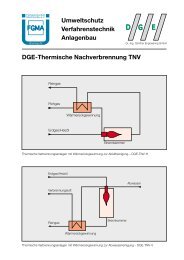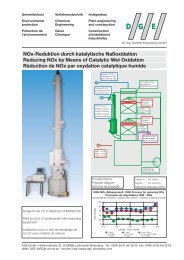Environmental protection Process engineering Plant ... - DGE GmbH
Environmental protection Process engineering Plant ... - DGE GmbH
Environmental protection Process engineering Plant ... - DGE GmbH
You also want an ePaper? Increase the reach of your titles
YUMPU automatically turns print PDFs into web optimized ePapers that Google loves.
<strong>Environmental</strong> <strong>protection</strong><br />
<strong>Process</strong> <strong>engineering</strong><br />
<strong>Plant</strong> <strong>engineering</strong><br />
3.1 Technological description of BCM-methods ®<br />
D G E<br />
Dr.-Ing. Günther Engineering <strong>GmbH</strong><br />
Biogas contains valuable raw-components. This invites the option of substance-utilization of these<br />
raw-components, since these can be processed independently of the utilization process of waste<br />
heat. The cleaning of biogas in order to remove NH3, H2S and exsiccation is a tried-and-true<br />
method and has already been in use. Its implementation is a prerequisite for substance-utilization<br />
of main components CH4 and CO2 which are contained in biogas. The <strong>DGE</strong> <strong>GmbH</strong> Company has<br />
developed four different cleaning and modification techniques for different available options of substance-utilization<br />
of biogas – ref. to the following shortened versions of descriptions.<br />
3.1.1 Means of biogas utilization BCM-0<br />
Natural gas production<br />
The basic method for the production of natural gas is the split-up of biogas into natural gas and<br />
carbon dioxide. As a result of a newly enacted Law of Renewable Energy Resources (EEG), the<br />
utilization of this method itself brings considerable advantages to everyone who operates a facility<br />
based on biogas, where this biogas is used to produce electrical power.<br />
3.1.2 Means of biogas utilization BCM-1<br />
Soda and natural gas production<br />
Biogas that comes out of a container is always cleaned first, using one washer; forming NH3 and<br />
H2S, and having been modified in this way, the biogas is further taken into the waste-gas washer,<br />
in which CO2 and NaOH are removed for the purpose of producing Na2CO3.<br />
Subsequently, with the use of a compressor, the cleaned-up biogas is compressed like a natural<br />
gas to reach the desired pressure. Following the first compression phase, gas dehydration is prescribed,<br />
along with the so-called “police filter”.<br />
The achieved quality of the natural gas is somewhere in the neighborhood of 98 vol. % CH4 and<br />
2 vol. % CO2.<br />
3.1.3 Means of biogas utilization BCM-2<br />
Compressive condensation in the production of split mixtures CO2/CH4<br />
Biogas that comes out of a container is always cleaned first, using one washer; forming NH3 and<br />
H2S, and having been modified in this way, the biogas is further taken into a compression device.<br />
The following condensation phase gives rise to the forming of a gas rich on methane, which is of<br />
the same quality as natural gas, and carbon dioxide saturated with methane is being obtained, as<br />
well.<br />
Following the first compression phase, gas dehydration is prescribed, along with the so-called “police<br />
filter”.<br />
The cleaned-up gas, just like natural gas (high-caloric gas), may be supplied into the (distribution)<br />
system or be used as fuel. The carbon dioxide (classified as low-caloric gas), which is obtained in<br />
<strong>DGE</strong> <strong>GmbH</strong> - Hufelandstraße 33 - D-06886 Lutherstadt Wittenberg<br />
Tel.: +49-3491-661841 - Fax: +49-3491-661842 - Email: <strong>DGE</strong>-INFO@t-online.de - Internet: www.dge-wittenberg.com


